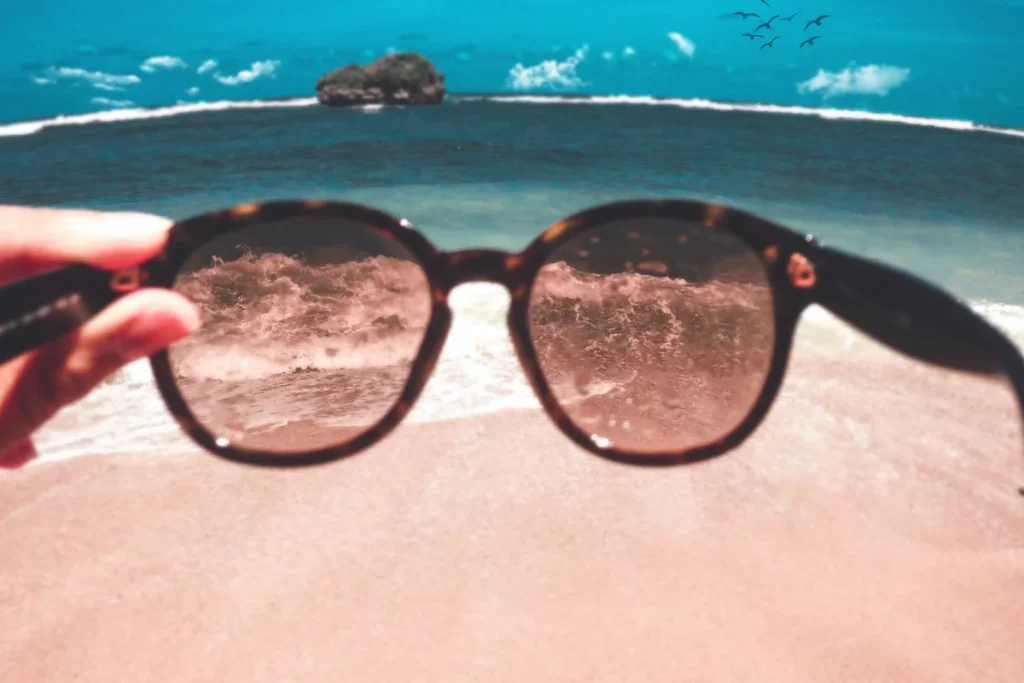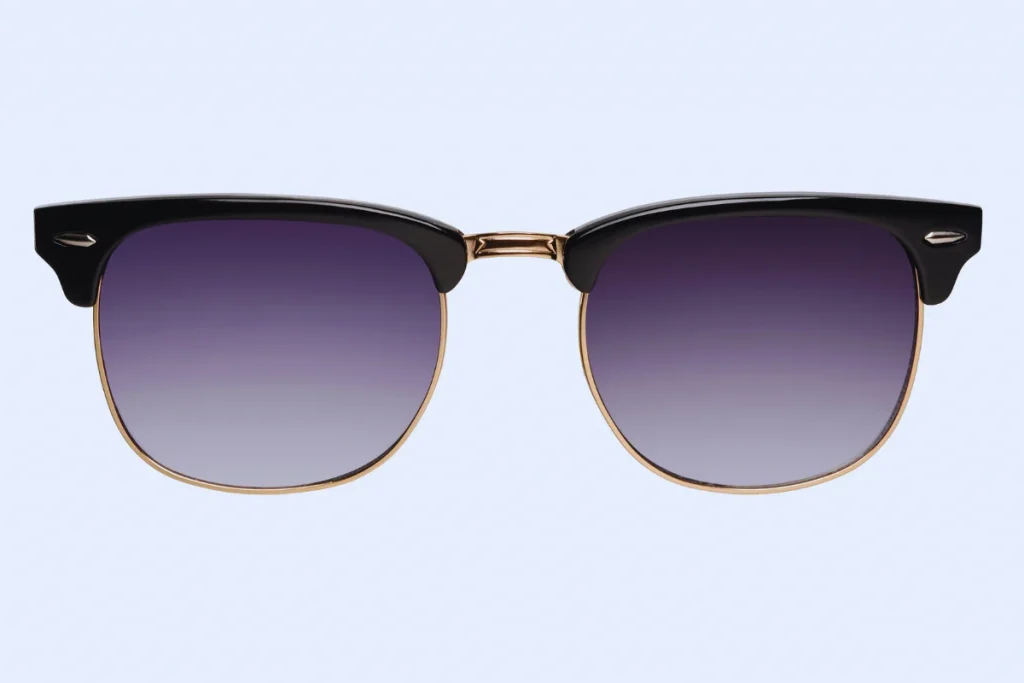Whether you’re driving on a sunny day, walking by the water or enjoying winter sports, glare from reflective surfaces can make it hard to see clearly. That’s where polarized sunglasses come in.
Polarized sunglasses are designed to reduce glare and improve visual comfort in bright outdoor settings.
Unlike regular sunglasses that only darken your view, polarized lenses block intense reflected light, so you can see more clearly and comfortably.
In this guide you’ll learn:
- What polarized sunglasses are
- How they work to reduce glare
- The main benefits they offer
- When they’re most useful
- How they differ from regular sunglasses
What Are Polarized Sunglasses?
Polarization in Simple Terms
Polarized sunglasses have a special chemical coating on the lenses that blocks intense reflected light. This reflected light, also known as glare, bounces off flat surfaces like water, roads, car hoods or snow and makes it harder to see.

The polarization filter works like a microscopic blind that blocks horizontal light waves — the kind that causes glare, while still allowing vertical light (which is useful for seeing) to pass through. This reduces the harsh reflections that cause squinting and eye strain.
When Polarization Is Most Useful
Polarized lenses are most helpful in outdoor environments where glare is common. Some examples include:
- Near water: Reduces the bright shine from lakes, oceans and pools
- On the road: Cuts glare from the pavement and other cars
- In snowy conditions: Improves visibility in bright, reflective snow
- During outdoor sports: Improve contrast and clarity for clearer vision
This is why polarized sunglasses are popular for drivers, boaters, skiers, hikers and anyone who spends time outside in bright light.
How Polarized Sunglasses Differ from Regular Sunglasses
Polarized vs Non-Polarized: What’s the Difference?
At first glance, polarized and non-polarized sunglasses may look similar — both darken your view and shield your eyes from bright light. But they work differently.
What Regular Sunglasses Do
Regular sunglasses are designed to reduce the overall brightness of sunlight. They tint your view and can make things more comfortable by limiting the amount of light that reaches your eyes.
But they don’t block glare, which is what causes intense reflections and visual discomfort.
What Polarized Sunglasses Do
Polarized lenses do more. In addition to reducing brightness, they filter out glare by blocking horizontal light waves. This means:
- Sharper vision
- Better contrast and color
- Less eye strain
- A clearer view in bright outdoor environments
So while regular sunglasses darken the light, polarized sunglasses improve what you see. They’re great for tasks that require clear vision like driving or being near water.
Key Advantages of Polarized Sunglasses
Polarized sunglasses are more than just a fashion choice. They offer strong protection and comfort for your eyes, especially in bright outdoor environments. Let’s take a closer look at the major benefits they provide.

1. Reduces Glare
Glare is caused by sunlight bouncing off flat surfaces like water, snow, pavement, and glass. This bright reflection can distort your vision and be uncomfortable or even dangerous in certain situations.
Polarized sunglasses have a special filter that blocks horizontal light wave,s which reduces glare significantly. So you can see more clearly and with less strain in high-glare environments.
For activities like driving, boating, fishing, skiing or walking near reflective surfaces.
Quick benefits:
- Blocks intense light reflections
- Improves clarity in high glare
- Reduces squinting in bright sun
2. Improves Visual Comfort
Outdoor light can be harsh, especially when you’re out for extended periods. Squinting and eye strain can ruin an otherwise nice day. Polarized lenses soften bright light and help your eyes relax. So you can be more comfortable whether you’re walking in a park or sitting on the beach.
Quick benefits:
- Reduces brightness without dimming your vision
- Helps eyes relax
- Makes outdoor time more enjoyable
Improves Clarity and Contrast
Polarized lenses do more than reduce brightness – they improve how you see the world. By blocking scattered light and glare they allow colors to pop and objects to stand out more.
This boost in clarity helps you navigate better and enjoy scenic views with more detail.
For outdoor activities that require visual precision like hiking, cycling and photography.
Quick benefits:
- Improves contrast and color sharpness
- Enhances detail and depth perception
- Makes nature and outdoor views more vibrant
4. Reduces Eye Fatigue
Staring into reflective surfaces or bright sunlight forces your eyes to work harder. Over time this leads to tiredness, blurred vision or even headaches.
Polarized lenses reduce the strain by giving your eyes a clearer and more consistent image to process.
Quick benefits:
- Decreases visual stress
- Prevents headaches and tired eyes
- Supports long term use
5. Increases Safety in Outdoor Activities
Whether you’re driving or on a trail your ability to see clearly affects your safety. Polarized lenses remove distracting glare and help you see objects, obstacles or movement more clearly.
This clearer view helps your reaction time and decision making during high speed or high risk activities.
For driving, cycling, running, and outdoor work.
Quick benefits:
- Sharpens vision in bright conditions
- Detects hazards faster
- Supports better coordination and safety
6. UV Protection
Polarized sunglasses often come with UV protection built in. UV exposure can cause long term damage like cataracts or age-related macular degeneration.
UV protection sunglasses vs polarized

By combining glare control and UV blocking, polarized sunglasses offer full spectrum protection for your eyes.
Quick benefits:
- Blocks UVA and UVB rays
- Reduces long-term eye health risks
- Safe for daily outdoor use
Who Benefits Most from Polarized Sunglasses?
Polarized sunglasses can benefit anyone, but some people and activities benefit more. If you spend a lot of time outdoors or are light sensitive, polarized lenses can make a big difference in how you see and feel throughout the day.
Drivers
When you’re on the road, glare from the sun bouncing off windshields, wet pavement or hoods of cars can be distracting and dangerous.
Polarized lenses reduce this glare and make it easier to see, especially during sunrise, sunset or after rain.
Why it matters:
- No more squinting behind the wheel
- Clearer road signs and vehicles
- Less eye strain and driving fatigue
Outdoor Workers
People who work outdoors — construction workers, landscapers, delivery drivers, farmers — are exposed to bright sunlight for hours a day.
This can lead to eye fatigue and discomfort. Polarized sunglasses help by reducing glare and long term visual comfort.
Why it matters:
- Clear vision all day long
- Protection from harsh reflections and sunlight
- Sharp vision for safety on the job
Water Sports Enthusiasts (Fishing, Boating)
Water is the most reflective surface, often causing strong glare that makes it hard to see what’s beneath the surface or around you. Polarized lenses are perfect for anyone who spends time on or near water, boaters, kayakers, anglers.
Why it matters:
- Reduces reflection off water surfaces
- Easier to see into the water
- Spot fish or underwater obstacles
Snow Sports Participants
Snow can reflect up to 80% of sunlight, causing intense glare that’s uncomfortable and even harmful. Whether you’re skiing, snowboarding or hiking in snowy conditions, polarized sunglasses can protect your eyes and improve your view.
Why it matters:
- No more snow blindness and glare
- See changes in terrain or slope
- Navigating snowy environments easier and safer
People with Light Sensitivity or Recent Eye Surgery
Some people are more light sensitive, others are recovering from eye procedures like LASIK or cataract surgery. In both cases, bright light can be uncomfortable or even painful. Polarized lenses help by reducing glare and brightness.
Why it matters:
- Soothes light-sensitive eyes
- Prevents overstimulation and discomfort
- Eases post surgery recovery by reducing eye strain
When Not to Use Polarized Sunglasses
Polarized sunglasses are incredibly helpful in many outdoor situations, but there are times when they might not be the best choice. Understanding when to avoid them can help you maintain clear, comfortable vision in all conditions.
In Low-Light or Cloudy Conditions
Polarized lenses are designed to reduce brightness and glare. However, in dim lighting or overcast weather, this effect can make your surroundings look even darker. This may reduce your ability to see clearly, especially in shaded or shadowed areas.
Why to avoid them:
- Vision may appear too dark in already dim environments
- Reduced contrast can make details harder to see
- Not ideal for cloudy days, early mornings, or late evenings
Helpful tip: On gloomy or low-light days, wear regular sunglasses with a lighter tint or no polarization for better visibility.
While Viewing Digital Screens
Some digital screens, especially older types like LCDs, do not interact well with polarized lenses. The screen may look oddly dark, rainbow-colored, or may even become completely unreadable from certain angles.
Why to avoid them:
- Text and images may appear distorted
- Can interfere with reading screens like phones, GPS, or car displays
- Causes inconvenience when using digital devices outdoors
Helpful tip: Test your polarized sunglasses with the screens you use most. If they distort the view, consider switching to non-polarized lenses for screen-heavy tasks.
During Aviation or Precision-Based Activities
In specific fields such as aviation or technical work, clear visual input is critical. Pilots, for example, may need to see glare reflections from other aircraft or read cockpit instruments clearly. Polarized lenses can sometimes block or distort these vital cues.
Why to avoid them:
- Important glare reflections may be reduced or removed
- Some instruments and controls may become hard to read
- Safety or performance may be affected in certain roles
Helpful tip: If your job involves flying or high-precision tasks, consult with your employer or optician to make sure polarized lenses are suitable.
How to Tell If Your Lenses Are Polarized
Not sure if your sunglasses have polarized lenses? Polarization isn’t always visible at first glance but there are easy ways to check.

Whether you’re curious about a new pair or want to test an old one, these simple methods will help you confirm if your lenses are polarized.
Quick At-Home Test
One of the easiest ways to test for polarization is by using your sunglasses with a digital screen, like a phone, computer or tablet.
Here’s how:
- Put your sunglasses in front of a screen (make sure the screen is bright).
- Rotate the sunglasses slowly 90 degrees.
- If the lenses are polarized you will see the screen go darker or even black out at a certain angle.
This happens because polarized lenses block certain light waves, including those from LCD screens.
Look for Glare Reduction
Another simple test is to wear the sunglasses and look at a reflective surface, like water, a glass window or a car hood on a sunny day.
What to look for:
- If the glare decreases and reflections become clearer or less intense, your lenses are probably polarized.
- If the glare stays the same or only dims slightly, they may not be polarized.
This is a real-world test to see how your lenses respond to reflected light, which is what polarization is designed to manage.
Use a Second Pair of Polarized Sunglasses
If you have two pairs of sunglasses and one of them is polarized, you can use them to test each other.
Here’s how:
- Place one pair in front of the other.
- Look through both lenses while holding them up to a light source.
- Rotate one of the pairs slowly.
- If both are polarized, the lenses will go darker or even black out at 90 degrees.
This cross-check method is simple and works well when testing multiple pairs.
Check the Labels
Sometimes the easiest answer is right on the lens or frame. Look for labels or engravings that say:
- “Polarized”
- “P” or “PL” on the lens or arms
If your sunglasses came with a case or packaging, it may also say if they are polarized. Note: Not all say “polarized” are polarized.
Daily Tips for Getting the Most Out of Your Polarized Sunglasses
To get the most out of your polarized sunglasses and keep them in good shape, use and care for them properly. Here are some simple daily tips to help you get the best every time you wear them.

Wear Them Outdoors in Bright Daylight
Polarized sunglasses work best in bright outdoor conditions. The more you wear them during sunny hours, the more you’ll notice how they reduce glare and improve clarity.
Tip: Put them on whenever you’re driving, walking or spending time outdoors in strong sunlight to protect your eyes and see sharper.
Keep Them Clean to Maintain Lens Clarity
Dust, smudges and fingerprints can reduce visibility and make your sunglasses less effective. Clean your lenses daily with a soft microfiber cloth and lens-safe cleaning solution.
Tip: Don’t use paper towels or clothing to wipe your lenses as they can cause scratches over time.
Use a Case When Not in Use
Even the best lenses can get scratched if you toss your sunglasses into a bag or leave them unprotected. A hard-shell or padded case keeps them safe from accidental damage.
Tip: Make it a habit to store your sunglasses in a case every time you’re not wearing them, especially when traveling or driving.
Don’t Wear Them at Night or in Dark Indoor Spaces
Polarized lenses are designed to reduce brightness and glare, so they can make low-light environments too dim. Wearing them in these situations may reduce your ability to see clearly.
Tip: Switch to clear or lightly tinted lenses for nighttime driving or indoor use.
Don’t Use Them When Viewing Certain Screens
Some LCD screens, like those on phones, ATMs or GPS devices, may appear dark or distorted when viewed through polarized lenses. This is because the lenses filter light.
Tip: If you need to read a digital screen in bright sunlight, try tilting your head slightly or temporarily removing your sunglasses to get a clearer view.
Final Words
Polarized sunglasses are more than just a fashion accessory.
They protect your eyes, reduce harsh glare and make your vision clearer and more comfortable during outdoor activities. Whether you’re driving, fishing, walking or working under the sun, these lenses make your experience easier on the eyes.They also block UV rays which is good for your eye health over time.
If you’re outdoors a lot, wearing polarized sunglasses is a smart and easy way to look after your vision.
Wear them often in bright light, keep them clean and store them safely when not in use. Simple habits like these will go a long way to keep your eyes comfortable and protected daily.
FAQs About Polarized Sunglasses
Q1: What are the benefits of polarized sunglasses?
Polarized sunglasses reduce glare from reflective surfaces like water and snow, improve visual clarity and contrast, minimize eye strain during prolonged sun exposure, and often include UV protection for long-term eye health.
Q2: Are polarized sunglasses better than regular sunglasses?
Yes, because while regular sunglasses only block brightness, polarized lenses also block horizontal glare, resulting in sharper vision, less squinting, and more comfortable viewing in bright environments.
Q3: Do polarized sunglasses block UV rays?
Polarization itself does not block UV, but most polarized lenses come with UV400 protection that blocks 99–100% of UVA and UVB rays, protecting eyes from sun damage.
Q4: Can polarized sunglasses hurt digital screen visibility?
Yes. Polarized lenses can cause LCD screens (such as those on phones, GPS, or dashboards) to appear dark or distorted when viewed at certain angles.
Q5: Are polarized sunglasses suitable for driving?
They are an excellent choice for daytime driving, as they reduce eye fatigue and glare from roads and other vehicles. However, they may interfere with some car dashboard or head-up display screens .
Q6: Can you wear polarized sunglasses at night or on cloudy days?
Polarized lenses can reduce overall brightness, making vision too dim in low-light or overcast conditions. For evening use, non-polarized or lightly tinted lenses are better.
Q7: Who should consider polarized sunglasses?
People who drive frequently, spend time near water or snow (like skiers, boaters, anglers), work outdoors, or have light-sensitive eyes will benefit most from polarized lenses


